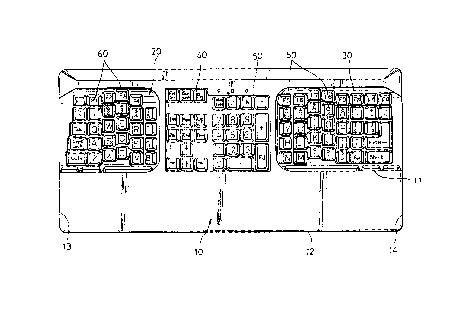Une partie des informations de ce site Web a été fournie par des sources externes. Le gouvernement du Canada n'assume aucune responsabilité concernant la précision, l'actualité ou la fiabilité des informations fournies par les sources externes. Les utilisateurs qui désirent employer cette information devraient consulter directement la source des informations. Le contenu fourni par les sources externes n'est pas assujetti aux exigences sur les langues officielles, la protection des renseignements personnels et l'accessibilité.
L'apparition de différences dans le texte et l'image des Revendications et de l'Abrégé dépend du moment auquel le document est publié. Les textes des Revendications et de l'Abrégé sont affichés :
| (12) Demande de brevet: | (11) CA 2189398 |
|---|---|
| (54) Titre français: | CLAVIER ERGONOMIQUE POUR ORDINATEUR |
| (54) Titre anglais: | ERGONOMIC COMPUTER KEYBOARD |
| Statut: | Réputée abandonnée et au-delà du délai pour le rétablissement - en attente de la réponse à l’avis de communication rejetée |
| (51) Classification internationale des brevets (CIB): |
|
|---|---|
| (72) Inventeurs : |
|
| (73) Titulaires : |
|
| (71) Demandeurs : |
|
| (74) Agent: | SMART & BIGGAR LP |
| (74) Co-agent: | |
| (45) Délivré: | |
| (22) Date de dépôt: | 1996-11-01 |
| (41) Mise à la disponibilité du public: | 1998-05-01 |
| Requête d'examen: | 1996-11-01 |
| Licence disponible: | S.O. |
| Cédé au domaine public: | S.O. |
| (25) Langue des documents déposés: | Anglais |
| Traité de coopération en matière de brevets (PCT): | Non |
|---|
| (30) Données de priorité de la demande: | S.O. |
|---|
Clavier d'ordinateur ergonomique, présentant une plage avant, un bloc alphanumérique divisé en deux parties logées chacune dans une dépression de contour arrondi, l'une à droite et l'autre à gauche du clavier, et, entre celles-ci, un bloc numérique et un bloc de touches de directivité.
An ergonomic computer keyboard including a front
edge section, a character control section, an edit
control section, and a number control section, wherein
the character control section includes a left
character control section and a right character
control section, the left character control section
and the right character control section having a
respective hollow, rounded shape; the edit control
section and the number control section are arranged
between the left character control section and the
right character control section.
Note : Les revendications sont présentées dans la langue officielle dans laquelle elles ont été soumises.
Note : Les descriptions sont présentées dans la langue officielle dans laquelle elles ont été soumises.

2024-08-01 : Dans le cadre de la transition vers les Brevets de nouvelle génération (BNG), la base de données sur les brevets canadiens (BDBC) contient désormais un Historique d'événement plus détaillé, qui reproduit le Journal des événements de notre nouvelle solution interne.
Veuillez noter que les événements débutant par « Inactive : » se réfèrent à des événements qui ne sont plus utilisés dans notre nouvelle solution interne.
Pour une meilleure compréhension de l'état de la demande ou brevet qui figure sur cette page, la rubrique Mise en garde , et les descriptions de Brevet , Historique d'événement , Taxes périodiques et Historique des paiements devraient être consultées.
| Description | Date |
|---|---|
| Demande non rétablie avant l'échéance | 1999-11-01 |
| Le délai pour l'annulation est expiré | 1999-11-01 |
| Inactive : Abandon. - Aucune rép dem par.30(2) Règles | 1999-01-25 |
| Inactive : Renseign. sur l'état - Complets dès date d'ent. journ. | 1999-01-06 |
| Réputée abandonnée - omission de répondre à un avis sur les taxes pour le maintien en état | 1998-11-02 |
| Inactive : Dem. de l'examinateur par.30(2) Règles | 1998-09-25 |
| Demande publiée (accessible au public) | 1998-05-01 |
| Toutes les exigences pour l'examen - jugée conforme | 1996-11-01 |
| Exigences pour une requête d'examen - jugée conforme | 1996-11-01 |
| Date d'abandonnement | Raison | Date de rétablissement |
|---|---|---|
| 1998-11-02 |
Les titulaires actuels et antérieures au dossier sont affichés en ordre alphabétique.
| Titulaires actuels au dossier |
|---|
| SHIH-MING CHENG |
| Titulaires antérieures au dossier |
|---|
| S.O. |